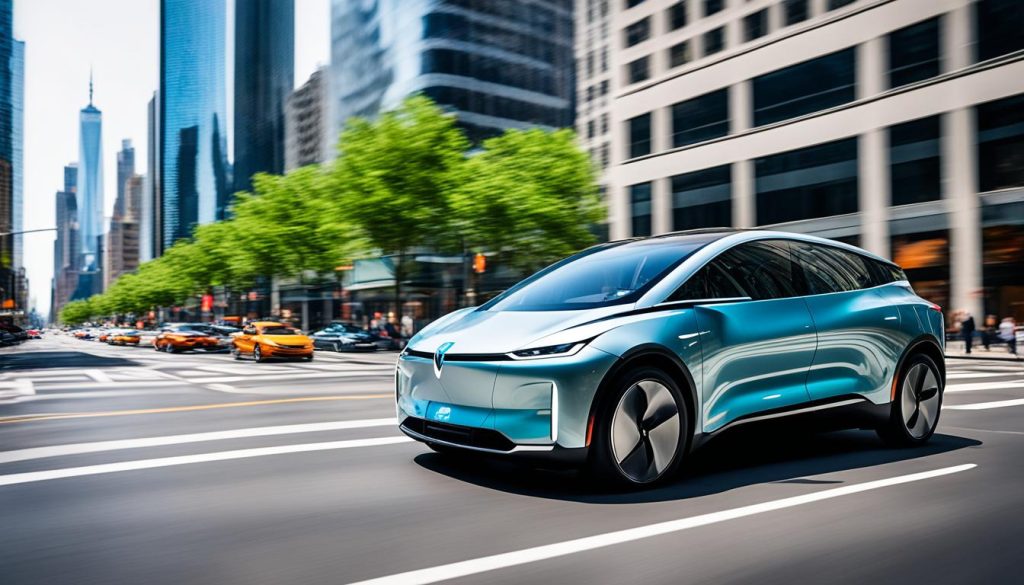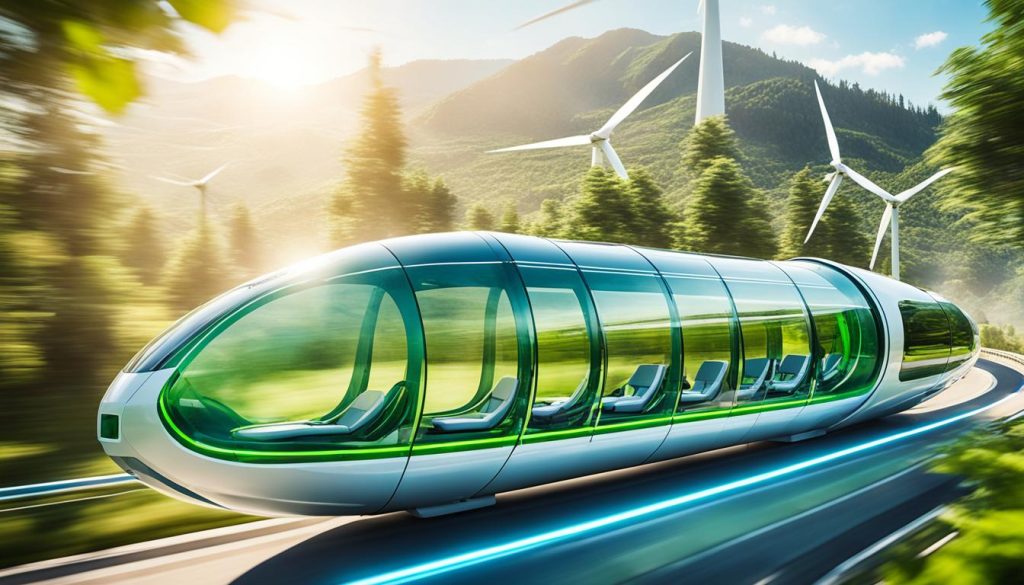Sustainable mobility trends are playing a significant role in transforming the transportation industry into a more eco-friendly and sustainable sector. As travelers and businesses alike become increasingly conscious of their environmental impact, innovative solutions are emerging to promote green and sustainable mobility.
From eco-friendly transportation innovations to premium environmentally conscious mobility solutions, the focus is on reducing emissions, promoting responsible practices, and fostering a greener future for transportation.
Key Takeaways:
- Sustainable mobility trends are revolutionizing the transportation industry.
- Eco-friendly transportation innovations offer greener alternatives.
- Green and sustainable mobility solutions prioritize reducing emissions.
- Premium environmentally conscious transportation trends are gaining popularity.
- Exclusive sustainable mobility practices are shaping the future of travel.
Intelligent Traffic Management Systems and the Reduction of Congestion
Intelligent Traffic Management Systems (ITMS) are revolutionizing the way we navigate roads and highways, tackling the recurring issue of traffic congestion head-on. By incorporating advanced technologies such as Artificial Intelligence (AI) and machine learning, ITMS optimizes traffic flow, enhances safety, and improves fuel efficiency, making it a vital component of modern transportation infrastructure.
One of the key features of ITMS is its ability to dynamically adjust signal timings based on real-time traffic conditions. This ensures that traffic flows smoothly and efficiently, reducing congestion and minimizing delays. By streamlining the movement of vehicles, ITMS not only improves the overall traffic experience but also enhances safety on the roads.
On top of traffic flow optimization, ITMS also plays a crucial role in fuel efficiency. By analyzing traffic patterns and adjusting signal timings accordingly, it helps to minimize unnecessary starts and stops, which are major contributors to fuel wastage and emissions. This not only benefits individual drivers by reducing fuel costs but also contributes to a greener and more sustainable transportation system.
The data generated by ITMS is also invaluable for urban planning and infrastructure improvements. Traffic data analysis provides valuable insights into the usage patterns of roads and highways, enabling authorities to make informed decisions for road expansions, new construction projects, and other transportation-related developments. By leveraging this data, cities can proactively address traffic congestion and provide better road infrastructure to accommodate future growth.
“Intelligent Traffic Management Systems are transforming the way we manage traffic, offering solutions to alleviate congestion, enhance safety, and optimize fuel efficiency. By harnessing the power of advanced technologies, ITMS sets a new standard for modern transportation systems.”
The Benefits of Intelligent Traffic Management Systems:
- Traffic congestion reduction: ITMS optimizes traffic flow and minimizes congestion, resulting in smoother journeys and reduced travel times.
- Safety enhancement: By dynamically adjusting signal timings and providing real-time traffic information, ITMS enhances safety for drivers, passengers, and pedestrians.
- Fuel efficiency: ITMS minimizes unnecessary stops and starts, leading to improved fuel efficiency and reduced emissions.
- Data-driven infrastructure improvements: The data generated by ITMS enables cities to make informed decisions for better urban planning and infrastructure enhancements.
Intelligent Traffic Management Systems are paving the way for a smarter and more efficient transportation future. By addressing the challenges of traffic congestion, optimizing traffic flow, enhancing safety, and improving fuel efficiency, ITMS represents a major leap forward in sustainable mobility.
The Rise of Electric and Autonomous Vehicles in Sustainable Mobility
The transportation industry is experiencing a revolution with the rise of electric vehicles (EVs) and autonomous vehicles. Not only do these technologies offer numerous benefits, such as reduced fuel costs and increased efficiency, but they also contribute to environmental sustainability.
Electric vehicles are major game-changers when it comes to reducing greenhouse gas emissions. By eliminating the need for traditional fossil fuels, EVs have a significantly smaller carbon footprint. In addition, advancements in renewable energy sources have made it possible to integrate these clean vehicles into a sustainable charging infrastructure.
Alongside EVs, autonomous vehicles have the potential to enhance safety on the roads. By minimizing human errors and accidents, autonomous technology can significantly reduce road fatalities. This not only promotes a safer environment for commuters but also aligns with the goal of enhanced safety in transportation.
An exciting prospect in the world of autonomous vehicles is the advent of shared mobility services. Through autonomous technology, vehicles can be efficiently utilized by multiple users, reducing the need for individual car ownership. This optimization of road space leads to decreased congestion and increased efficiency in transportation networks.
To further illustrate the benefits of electric and autonomous vehicles, let’s take a look at a comparison table:
| Benefits | Electric Vehicles (EVs) | Autonomous Vehicles |
|---|---|---|
| Environmental Sustainability | Significantly reduce greenhouse gas emissions | Minimize human errors, reducing accidents |
| Reduced Fuel Costs | Lower operating costs compared to conventional vehicles | N/A |
| Enhanced Safety | N/A | Potential to improve road safety by minimizing human errors |
| Increased Efficiency | N/A | Optimize road space utilization through shared mobility services |
As we can see from the comparison table, electric and autonomous vehicles offer distinct advantages in different aspects. Combining these technologies can lead to a transportation system that is both environmentally sustainable and efficient.
With continuous advancements in electric and autonomous vehicle technologies, the future of sustainable mobility looks promising. As the adoption of these vehicles becomes more widespread, we can expect reduced emissions, safer roadways, and an enhanced overall transportation experience.

Hyperloop Technology Revolutionizing Long-Distance Travel
Hyperloop technology, first proposed by Elon Musk, has the potential to revolutionize long-distance travel. This innovative mode of transportation enables ultra-fast travel speeds of up to 700 mph, significantly reducing travel times for passengers.
One of the key advantages of Hyperloop technology is its energy efficiency. Compared to traditional transportation methods like airplanes or cars, the Hyperloop system consumes significantly less energy, making it a greener alternative for long-distance travel. By using renewable energy sources to power the system, Hyperloop can further enhance its environmental sustainability.

The Hyperloop system can be built both above and below ground, minimizing land usage and reducing its impact on the environment. By utilizing a network of sealed low-pressure tubes, Hyperloop pods can travel at incredible speeds, providing an efficient and eco-friendly transportation option.
Moreover, Hyperloop networks have the potential to increase connectivity between cities, stimulating economic growth and development. By drastically reducing travel times, individuals and businesses can establish stronger connections, fostering collaboration and trade.
In summary, Hyperloop technology represents a paradigm shift in long-distance travel. With its ultra-fast speeds, energy efficiency, and increased connectivity, Hyperloop offers a greener alternative that can transform the way we travel. As this innovative technology continues to advance, it holds the potential to create a more sustainable and efficient transportation system for the future.
Smart Infrastructure and Connectivity for Efficient Transportation Systems
Smart infrastructure and connectivity play a crucial role in creating efficient transportation systems. Through the integration of advanced technologies, these systems enable real-time communication, enhance safety, and drive data-driven analytics for better urban planning and resource allocation. Let’s explore how smart infrastructure and connectivity revolutionize the way we travel.
Real-time Communication and Enhanced Safety
Intelligent transportation systems enable real-time communication between vehicles and infrastructure, fostering a safer and more connected travel experience.
Connected vehicles receive crucial data on traffic conditions, accidents, and road hazards, allowing drivers to make informed decisions and choose the best routes to their destinations. This real-time information helps reduce congestion, optimize traffic flow, and prevent accidents, ultimately enhancing safety for both drivers and pedestrians.
Smart Parking Systems
Smart parking systems offer efficient parking space availability, reducing traffic congestion in urban areas and improving the overall travel experience.
These systems utilize sensors and data analytics to provide real-time information on available parking spaces. Drivers can access this information through mobile apps, minimizing the time spent searching for parking and reducing traffic congestion. By streamlining the parking process, smart infrastructure contributes to a smoother and more efficient transportation system.
Data-driven Analytics for Urban Planning
Data-driven analytics enable better urban planning and resource allocation, leading to more efficient transportation infrastructure.
By analyzing data on traffic patterns, usage, and user preferences, city planners can make informed decisions when designing and improving transportation infrastructure. This data-driven approach helps optimize road networks, public transportation routes, and cycling lanes, ensuring a seamless and sustainable travel experience for everyone.
Benefits of Smart Infrastructure and Connectivity
| Better Traffic Management | Enhanced Safety | Improved Urban Planning |
|---|---|---|
| Real-time traffic data for optimal route selection | Reduced accidents and improved emergency response times | Optimized road networks and public transportation routes |
| Smart parking systems to reduce congestion | Effective traffic flow management | Data-driven decisions for resource allocation |
| Fuel efficiency and reduced emissions | Enhanced pedestrian safety | Improved cycling infrastructure |
By leveraging smart infrastructure and connectivity, transportation systems can operate more efficiently, reduce congestion, and enhance safety. The integration of real-time communication, smart parking systems, and data-driven analytics paves the way for a seamless and sustainable travel experience. As we continue to advance in technology, smart infrastructure and connectivity will play a crucial role in shaping the future of transportation.
Conclusion
The future of travel is increasingly focused on sustainability. As travelers become more conscious of their environmental impact, the transportation industry is embracing eco-friendly solutions to cater to greener travel options. The rise of electric and autonomous vehicles is revolutionizing mobility, reducing greenhouse gas emissions, and offering cost-effective alternatives. Additionally, the implementation of intelligent traffic management systems is optimizing traffic flow, enhancing safety, and improving fuel efficiency.
Carbon reduction technologies are also playing a crucial role in creating a sustainable transportation system. Innovations like sustainable air fuels and carbon removal technology are being developed to mitigate emissions and combat climate change. Furthermore, regenerative travel practices are gaining popularity, encouraging individuals to make conscious decisions that benefit the environment and local communities.
In line with sustainable travel trends, the industry is taking steps to minimize plastic and paper waste. Initiatives such as eliminating single-use plastics and adopting paperless solutions are becoming prevalent. By embracing these practices, we can create a plastic and paper-free industry, reducing waste and preserving our natural resources.
In conclusion, through sustainable travel trends, greener transportation options, the utilization of carbon reduction technologies, the implementation of regenerative travel practices, and the reduction of plastic and paper waste, we can build a greener and more environmentally conscious transportation system. Together, we can make a significant impact on our planet and ensure a sustainable future for generations to come.
FAQ
What are some sustainable travel practices?
Sustainable travel practices include packing light, choosing reusable items, staying at eco-friendly accommodations, supporting local communities, and engaging in responsible wildlife encounters.
How do Intelligent Traffic Management Systems work?
Intelligent Traffic Management Systems use advanced technologies like Artificial Intelligence (AI) and machine learning to optimize traffic flow, reduce congestion, and enhance safety on the roads. They dynamically adjust signal timings based on real-time traffic conditions and provide traffic data analysis for better urban planning and infrastructure improvements.
What are the benefits of electric and autonomous vehicles?
Electric vehicles significantly reduce greenhouse gas emissions and offer lower operating costs. Autonomous vehicles have the potential to improve road safety by minimizing human errors and reducing accidents. These technologies also pave the way for shared mobility services, reducing the need for individual car ownership and optimizing road space utilization.
How does Hyperloop technology revolutionize long-distance travel?
Hyperloop technology enables speeds of up to 700 mph, significantly reducing travel times. Hyperloop systems are more energy-efficient compared to traditional modes of transportation and can be built both above and below ground, minimizing land usage. They also have the potential to increase connectivity between cities, stimulating economic growth and development.
What is the role of smart infrastructure in efficient transportation systems?
Smart infrastructure and connectivity enable real-time communication between vehicles and infrastructure, enhancing safety and reducing accidents. Connected vehicles receive data on traffic conditions, allowing drivers to choose the best routes and reduce congestion. Smart parking systems enable quick and efficient parking space availability, reducing traffic congestion in urban areas. Data-driven analytics facilitate better urban planning and resource allocation for transportation infrastructure improvements.
Why is sustainability important in the travel industry?
Sustainability is important in the travel industry to reduce environmental impact and support local communities. Carbon reduction technologies, regenerative travel practices, and initiatives to reduce plastic and paper waste are being adopted to create a greener and more environmentally conscious transportation system.



